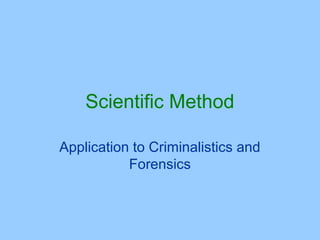
Scientific method
- 1. Scientific Method Application to Criminalistics and Forensics
- 2. What is Forensics? • Forensics is the application of science to the law that is enforced by local law enforcement. • There two critical pieces that make up forensics (also known as criminalistics): – Crime Scene investigator: The people who interpret what is and is not evidence at a crime scene, as well as putting together the puzzle of what happened. – Laboratory technicians: The people who are the experts at analyzing evidence (prints, DNA, etc.)
- 3. The most common subjects • Chemistry • Fingerprints • Biology • Odontology • Firearms/ballistics • Engineering • Document • Geology examination • Entomology • Toxicology/drug • Physics analysis
- 4. Scientific method • In science, as you all know, we use the scientific method to answer questions. • What are the parts of the scientific method? • Make an observation • Form a hypothesis • Create/perform an experiment • Scientific Theory • Scientific Law
- 5. What does it look like in Forensics? If hypothesis is false Make slight modifications Observations Hypothesis Experiment Theory Experiments Collect evidence Observations Experiments Conclusion/final Wait for more hypothesis evidence to appear Collect evidence Turn the case over to the judicial system There is a constant evolution of the original ideas based on the evidence found and the conclusions made.
- 6. Lab write-ups • Title • Procedure – Details, details, details. • Background information – Done before the labs • Data collection – Observations, data tables, Calculations • Purpose • Presenting data and • Hypothesis Graphs – Pictures of scene • Diagram – Pictures of apparatus used • Conclusion with labels – Analyze the data
- 7. Expectations on labs • Do your own work! • Organization and neatness counts – If I can’t read it or find it then its worthless • Complete analysis of evidence – Analyzing evidence is the point of this class • Thorough conclusions in complete sentences – Prove to me you know what you are talking about